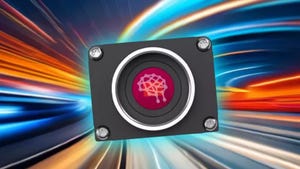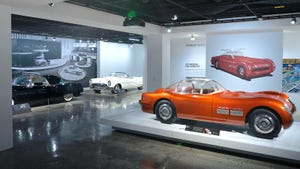April 8, 2011
Integrated assemblies are the Holy Grail for designengineers because they lighten structures, reduce assembly costs, and increasestrength.
In the new approach being used by Boeing with helpfrom NASA, dry carbon fiber structures are stitched together and then placed ina heated tool. A vacuum is pulled and epoxy resin is infused into thestructure.
"The composites technology used in the (787)Dreamliner is 25 to 30 years old," says Andy Harber, senior project manager,design engineering for Boeing. "In the new approach, there is no lay-up and noautoclaves."
787 Composites
The Dreamliner represented a dramatic increase in aircraft composites'use, with about half of the structure made with carbon-reinforced plastic(CFRP). As reported by DesignNews in an award-winning series, the conceptrequired development of autoclaves larger than those ever previously used.
Boeing Eyes Next-Generation Composites_A |
Otherwise, the technology was similar to compositestechnology long-used in making fiberglass composites. Hand lay-up is an openmold process in which successive plies of reinforcing material, usuallyfiberglass or resin-impregnated reinforcements are applied to a mandril. Curingis accelerated in an autoclave.
Deliveries of the Dreamliner are running more thanthree years late because of a variety of problems, including issues withfasteners and attachment points in the composite structure.
No decision has been made at Boeing about potentialuse of the new assembly technology for commercial aircraft. But Harber saysBoeing expects to use the technology in a next-generation blended wing bodyaircraft designed for reduced noise and pollution.
Combat Testing
The process received its first field test asreplacement landing gear doors in C-17s used as transportaircraft in Afghanistan. "On Sept. 17, 2009, we delivered to NATO eight landinggear doors featuring resin-infused, stitched composites," says Harber.
The original doors were made with traditionalmaterials and had taken a beating in the rough landing environment in thebattle zone. Tools for the C-17 doors were developed by Process Fab Inc.
The first licensee for the Boeing-developedtechnology is General Dynamics Armament and Technical Products, which wasawarded a $17 million contract by Boeing for the production of compositecomponents and spares for the C-17 Globemaster III aircraft. Production andprogram management is being done at General Dynamics' advanced materialsfacility in Marion, VA.
Boeing Eyes Next-Generation Composites_B |
The latestversion of the Boeing composites technology is called Pultruded Rod StitchedEfficient Unitized Structure (PRSEUS).
"This iscompletely reinventing how a composite structure is designed and manufactured,"says Harber. One of the keys is a vacuum infusion process in which a minimalamount of resin is pulled into a tool to cover the fibers.
Another keyto the use of PRSEUS is use of a pultruded rod attached to the skin as astiffener. This could eliminate the need for thousands of fasteners on anentire aircraft. Pultrusionis a process dating back to the1950s in which composites are pulled through a heated die, creating a verystrong linear shape. Many ladder rails are made via the pultrusion process.
Phantom Works
The test bedfor this new materials technology is an experimental aircraft developed byBoeing and NASA called the X-48. To date, the aircraft has been unmanned and built to small scale for testing purposes.
Boeing'sPhantom Works has been developing the blended wing body aircraft concept incooperation with the NASA Langley Research Center. Two models have been builtunder contract by Cranfield Aerospace in the UK. NASA and Boeing completedinitial flight testing of the Boeing X-48B last year.
"Thisproject is a huge success," says Fay Collier, manager of the project in NASA'sAeronautics Research Mission Directorate. "Bottom line: the team has proven theability to fly tailless aircraft to the edge of the low-speed envelope safely."
The blended wing body is a dramatic departurefrom the "tube-and-wing" approach used in commercial planes. Many engineersfeel that design has reached its potential. It's not clear though howcomfortable passengers would feel in such a radical departure as the blendedwing.
PRSEUS technology is also a leap of faith for commercial aircraft, whereuse of traditional composites was a radical departure.
"Boeing isstudying a number of advanced materials including PRSEUS for use on futureairplanes," says Boeing spokesman Bret R. Gardner. "However, we have not madeany decisions about whether we will use this material or not."
But it will have life in the next phase of development for the blendedwing body aircraft, which remains an experimental aircraft.
Next yearNASA will test a mid-fuselage section of a hybrid wing body aircraft made withthe PRSEUS technology to determine its potential flight worthiness.
If all goes well, Boeing will use its jointly developed blended wing body asan entry in the Environmentally ResponsibleAviation Project sponsored byNASA. The project's primary goals are to develop unconventional aircraftdesigns with the potential to reduce noise, fuel burn and nitrogen oxides (NOx)emissions.
Environmental Project
Boeing ispinning its hopes on the integrated assembly made possible with advancedcomposites technology as key to its work for NASA in developing anenvironmentally responsible aircraft.
For thisproject, the Boeing team will define a concept for an aircraft that can achievespeeds up to 85 percent of the speed of sound, cover a range of nearly 7,000miles, and carry between 50,000 and 100,000 lb of payload, either passengers orcargo.
You May Also Like





